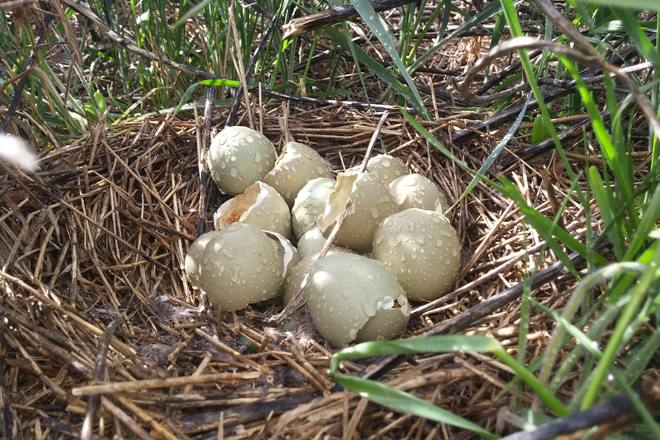Story by Jared Wiklund
As the spring nesting season transitions into the brood-rearing phase for ring-necked pheasants, “The Habitat Organization” is reminding landowners to minimize roadside disturbances – ditch mowing, haying, spraying and ATV operation – until August 1st to protect upland birds and other wildlife. Roadsides remain an important habitat component for pheasants throughout their range, and a myriad of other wildlife also reap the benefits of undisturbed roadside habitat.
The Ditch Effect
“In the lean years before the Conservation Reserve Program, roadside ditches were a major source of pheasant production,” commented Jim Wooley, emeritus biologist Pheasants Forever/Quail Forever and a lifelong upland specialist with more than 40 years of experience. “We don’t seem to give roadsides the same consideration nowadays. This is a shortsighted approach to wildlife management since roadsides are a very important component in the grand scheme of habitat – always have been and always will be.”
Though pheasants and waterfowl are often seen along roadsides, few people realize the importance of roadside ditches to wildlife. Research has shown that up to one-third of all pheasants produced may come from this important habitat structure – an even more critical statistic for intensively row cropped regions where undisturbed grassland habitat can be sparse. Likewise, waterfowl nesting research has shown shorelines and roadsides contain the highest number of nests-per-acre. In Minnesota alone, roadsides represent over 500,000 acres of permanent grassland in the state’s pheasant range.
Roadsides form an extensive network of grassy corridors and provide nesting, brood-rearing, and winter cover for pheasants and other wildlife. As urban sprawl and intensified agricultural demand have replaced pristine prairies, grassy roadsides oftentimes provide the only significant source of nesting cover for pheasants. What’s more? Roadsides also provide vital habitat for monarchs, mallards, teal, gray partridge, grassland songbirds, native pollinators, honeybees, frogs and turtles.
Just the Facts
A nesting hen lays eggs at a rate of about one per day. Early season nests contain an average of 10 to 12 eggs, but each subsequent re-nesting drops the egg count by two on average. The incubation period is 23-28 days and starts after all eggs have been laid. The hen remains very faithful to the nest, leaving only briefly to feed, and is therefore vulnerable to mowing during this time.
 Photo by Mick Harrington
Photo by Mick Harrington
Throughout pheasant country, hens will make up to four (4) attempts at nesting during the season but will only hatch one brood per year. The majority of nests hatch by mid-June, but up to 40 percent of re-nesting attempts hatch throughout July, stretching out the nesting season and highlighting the importance of delayed roadside disturbances. By August 1st, the reproductive season is over for most pheasants with the exception of a few late re-nesting attempts. Have you ever wondered if the combination of mowing, nest predation and environmental factors contributed to a late-summer hatch? The sheer number of juvenile roosters taken during the opening weekend of pheasant season is a great indicator – the fall of 2019 was a prime example as social media was littered with tailgate photos of immature roosters after the opening bell.
Pheasant Math: Best Scenario
• Pheasant nest initiation: May 1
• Total of 12 eggs laid: May 13
• Hatched eggs after maximum incubation period of 28 days: June 10
• Wait period of three weeks for chicks to be flight ready: July 1
With an average nest success rate of 40 to 60 percent and re-nesting attempts needing time for all eggs to be laid, it’s easy to see why August 1st is the recommend date to delay disturbance of roadsides.
Pheasants Forever encourages landowners and government authorities to consider the benefits for wildlife when making roadside land management decisions this summer.
Jared Wiklund is Pheasants Forever’s public relations manager.